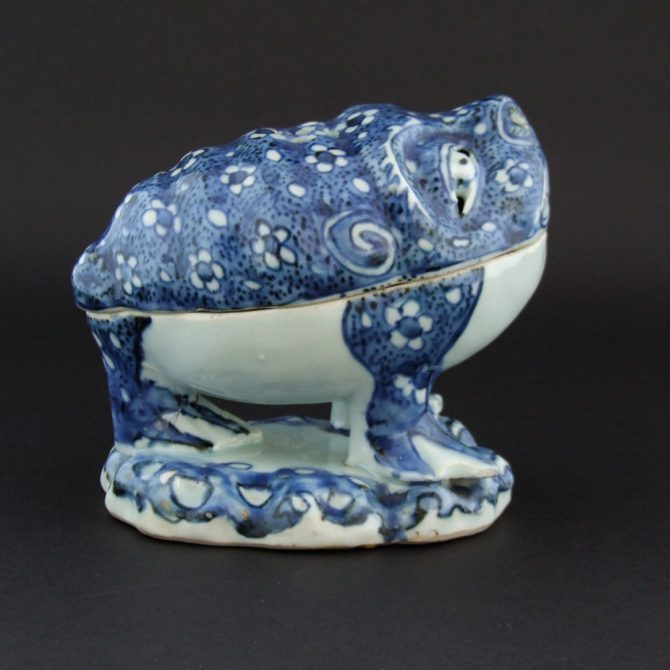
WANLI or CHONGZHEN c.1620 – 1630 Ming Porcelain
A Rare Ming Blue and White Porcelain Censer in the Form of Liu Hai`s Three-Legged Toad. Late Wanli, Tianqi or Early Chongzhen c.1620 – 1630, Made for the Japanese Market. The Amphibian Modelled with Rounded Ridges and Furrows to it`s Back and Decorated with Flower-Heads Against a Seeded Ground. The Legs Similarly Decorated. The Base with a Roughened Surface Resembling Rocky Ground or Perhaps Water. The Nostrils and Whites of the Eyes are Pierced, there are Also Five Pierced Slits to the Top of the Back Which Form the Marks on a Coin. The Cobalt Blue is Bright and Clear and the Glaze is Rather Pure.
SOLD
- Condition
- In very good condition, a very small flake type shallow chip underneath the front claws on one leg c.4 x 3 mm, with a minute glaze chip either side c.2 x 2 mm. The with a smaller chip.
- Size
- Length : 14.8 cm (5 3/4 inches)
- Provenance
- N/A
- Stock number
- 23557
- References
- For a very similar (but not the same) Ming blue and white censer see : Fine Asian Art, Bonham`s, London, 11th November 2002, lot 239. £17,000 hammer price. For a Ming blue and white `frog` (toad) ewer which has very similar decoration to the present example see : Fine Chinese Ceramics and Works of Art, Sotheby`s London, 7th November 2007, lot 316. For a small Ming blue and white porcelain censer with Liu Hai riding on top of his toad see : The Peony Pavilion Collection : Chinese Tea Ceramics for Japan (c.1580-1650), Christie`s London 12th June 1989, lot 204.
Information
Objects like the present example were used for burning incense, such as rare perfumed wood or blended ground mixtures, after the tea ceremony.
Lui Hai and the Three Legged Toad :
Figures and images of Lui Hai with his rounded bald head apart from some hair at the sides are well known. He is depicted as a young man who like the Eight Immortals holds his attribute, a string of cash (money). He is thought to have lived in the Jin Dynasty or perhaps the Han dynasty. There are many stories attached to this Immortal, one story recounts how he meet two holy men who asked him to give them a coin and ten eggs. They proceeded to stand the eggs one on top of another with the coin as a support. When Liu Hai pointed out this was a risky thing to do, they retorted it was no riskier than the way he was earning his living, in the service of princes. This opened Liu Hai`s mind and he became a Taoist. Liu Hai is revered god of wealth and is depicted with a three-legged toad and string of coins. In Japanese legend as Gama Sennin is connect with a money toad, the story of Gama Sennin is based on Liu Hai.